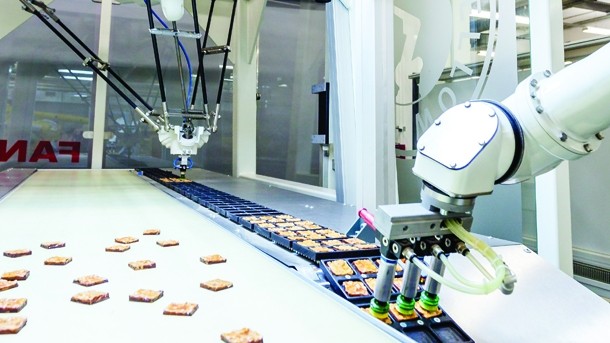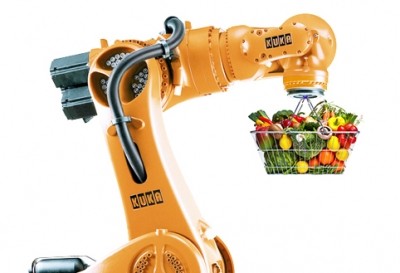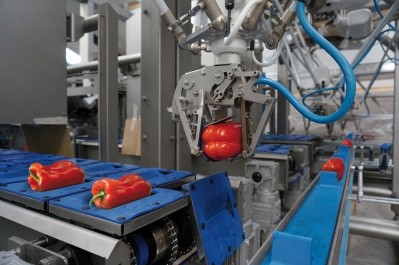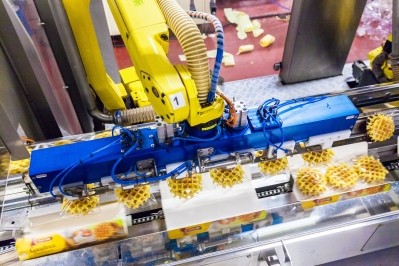Get to grips with robots

British firms are lagging behind their overseas counterparts when it comes to robotics, and this is especially true in the food industry. “In the UK for many years people have thought that robotics is going to take off in food and beverage. It’s slowly accelerating but the process is a lot more rapid in other countries – even low-cost countries,” says Alan Spreckley, global industry segment manager for food and beverage with ABB Robotics.
“It’s evolving very slowly in our experience, and that’s probably the same for our competitors,” agrees John Rainer, regional sales manager with Fanuc UK. He suggests that one reason might be the structure of the food chain in Britain and the behaviour of retailers: “In Scandinavia they’ll look at a five-year payback, but in the British food industry a supplier will only get a six-month contract from the supermarket, so how can they justify that sort of investment?”
However, he believes that if the traditional supermarkets are really interested in competing with the likes of Lidl and Aldi, they need to support manufacturers’ investments in automation in order to bring prices down: “They’re all moaning about losing out to discounters. They need to invest in getting manufacturing costs down.”
In addition, Spreckley says that overseas companies are more likely to take a range of things into consideration when calculating return on investment, such as health and safety, the cost of rework and quality issues, for instance. He says that this contrasts with ABB’s experience in the UK: “Payback is done in a simple way: How much do the robots cost and what’s the cost of the labour I’ll save?”
Today, Rainer says that you’re more likely to see robotic systems the further down the production line you go: “In palletisers and case packers, take-up is healthy and people aren’t afraid of doing it. But as you move up the line, fewer and fewer things get done by robots. Once you get up to handling the product itself, they’re few and far between.”
Concerns over hygiene (Return to top)
Concerns over hygiene and the ability of robots to withstand harsh cleaning regimes may historically have been one reason they have been kept at arm’s length when it comes to handling naked food products, but it should no longer be an issue, according to Rainer: “The wash down issue has to some extent gone away. We have both delta [spider robots] and six-axis [a type of robot arm] IP69k robots.”
Other companies have also cottoned on to food industry hygiene requirements. For instance, Omron already produces hygienic robots, but expects to announce a dedicated solution for food in the coming weeks, complete with full wash-down capabilities.
Whatever the hurdles, Fanuc announced recently that it had seen enquiries from food manufacturers looking to automate their food handling and packing operations increase by 35% over the past year.
Similarly, Omron’s marketing manager for motion and drives, Robert Brooks, says the company has noticed an upsurge of interest in the UK generally. “The important thing for us is that they’re not just saying it’s ‘interesting’ but they actually have projects in mind and robotics in mind as a possible solution,” he says.
Spreckley notes that a lot of the current interest is coming from smaller firms, rather than the biggest players: “SMEs [small manufacturing enterprises] are taking up automation faster than multinationals. One reason is that the added value per employee is far higher for large companies than smaller companies, so smaller companies have to be slicker and do more with fewer people if they’re going to compete with bigger companies.”
On the other hand, high-end robotic systems may be beyond the budget for smaller operations, so these companies will often resort to alternative automated solutions with lower up-front costs. For example, system integrator Pacepacker offers solutions based on delta robots and robotic arms, but often finds that lower-cost Cartesian systems are more suitable for tight budgets. In addition, the Cartesian systems can be supplied with controls ranging from simple pneumatics to the sort of servo motors used everywhere in robotics.
For a recent project to automate the packing of mixed pots of dip into boxes, Pacepacker supplied a Cartesian system with pneumatic controls. “All the pots were the same diameter and the same height,” says Paul Wilkinson, business development manager. “The actual boxes were also all the same footprint. They had one or two layers but they were all two by three rows. Given that we’ve got a number of static features we could look at the lower tech solution.”
Sledgehammer to crack a nut (Return to top)
He says that using robots in this kind of situation would be like using a sledgehammer to crack a nut. “Robots are big in pick-and-place but they shouldn’t be considered the be-all and end-all,” says Wilkinson. But he adds that robots really come into their own for projects where flexibility is needed: “What if my product changes? Or what about companies where they have different types of packaging? What if we’ll be changing the pack sizes for promotional giveaways? Those companies might need a more advanced solution.”
In this case, the ‘soft’ automation on offer from robotic systems is more adaptable than ‘hard’ solutions, says Ron Fortman, chief technology officer with Blueprint Automation (BPA): “They’re highly flexible and easy to reprogram. The ‘hands’ [end effectors], ‘eyes’ [vision systems] and movement are all easy to replace. A more dedicated machine will be more quickly obsolete or will need to be overhauled if you need to change the product.”
One of the most common places to find robots working with food is in pick-and-place operations. Here, delta robots are especially popular, often working in groups. They’re all about speed and they’re getting faster in order to keep pace with increased line speeds. “In the past, say you picked 300 products per minute with four robots, you can now do it with three, reducing the footprint and cost,” says Fortman.
However, he says that faster line speeds are largely a result of improved control of the overall system, rather than faster cycle times for each robot. That’s because the cycle speed is often limited by the application and products being handled, rather than the robot itself: “Especially if you’ve got a very fragile product, you can’t pick faster than a certain speed because you’re likely to damage or lose the product. So it’s more about intelligence in movement and reducing the waiting times in the line.”
Improved control (Return to top)
Omron also cites improved control and integration as key factors driving the adoption of robotic systems. “Improvements in functionality are helping to speed up the process, although it’s more evolution than revolution,” says Brooks. For instance, he says that the development of blended trajectories (smoother motion that blends one movement into the next) is improving line speeds and reducing the mechanical shock on systems at the same time. Another example is a function enabling the robot to carry out a process while the conveyor continues moving, rather than having to stop the line. This significantly improves throughput without reducing quality.
“Improved integration of the robotic controller, advanced vision systems and safety within Omron’s Sysmac automation platform, also means simplified machine design and faster software development for the user,” says Brooks. Also, the ability to link to databases easily means data can be stored and retrieved as necessary. This all means that machines are faster and more flexible, while project costs are reduced, he adds.
Ultimately, the uptake of robotics in the UK will depend on whether the potential benefits on offer can overcome the resistance of risk-averse boardrooms. “If it runs correctly it’s very easy to operate but companies are worried they need staff trained in robotics if something goes wrong,” says Fortman.
That’s why support packages featuring remote diagnosis and repair are typically offered as standard by robotics suppliers. ABB, for example, maintains a two-way dialogue between its installations and service engineers via the mobile phone network and will even install mobile phone network boosters if coverage is poor on its customer’s site. Using the phone network avoids having to communicate via the end user’s systems so it doesn’t compromise security.



















